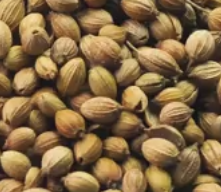The leaves and seeds of the cilantro or coriander plant (Coriandrum sativum) are used to extract the essential oil through steam distillation.
Step-by-step summary of the process.
- Cultivation and Harvesting. Coriander is grown and harvested when it reaches optimal maturity.
- Preparation. The leaves or seeds are cleaned and prepared for distillation.
- Steam Distillation. The plant parts are subjected to steam distillation to extract the essential oil.
- Separation and Collection. The essential oil is separated from the water and collected.
- Bottling. The cilantro essential oil is then bottled and sealed for distribution.
Form and color. Cilantro essential oil is typically a clear liquid with a yellow-green hue and has a fresh, herbaceous, slightly spicy scent.
Commercial applications.
Cilantro essential oil is utilized in various industries, such as aromatherapy, perfume production, cosmetics, and the food industry, for flavoring products and as an antibacterial agent.
Cosmetics
Fragrance. It plays a very important role in the formulation of cosmetic products as it provides the possibility of enhancing, masking or adding fragrance to the final product, increasing its marketability. It is able to create a perceptible pleasant odour, masking a bad smell. The consumer always expects to find a pleasant or distinctive scent in a cosmetic product.
Skin conditioning agent. It is the mainstay of topical skin treatment as it has the function of restoring, increasing or improving skin tolerance to external factors, including melanocyte tolerance. The most important function of the conditioning agent is to prevent skin dehydration, but the subject is rather complex and involves emollients and humectants that can be added in the formulation.
Coriander or Cilantro (Coriandrum sativum, L.) is an annual herb that belongs to the Apiaceae family.

It is grown for its leaves and aromatic seeds in Europe, North Africa and Asia as medicinal and culinary grass.
The chemical composition of Coriander's essential oil sees Linalool 57.57%, Geramil acetate 15.09% and Camphor 3.02% as the main ingredient. There are also small amounts of Geraniol 0.24%, Limonene 0.62%, Menthol 0.54%, Eugenol 0.76% (1).
This study examines the effects of essential oil chemically characterized by Coriandrum sativum leaves on the viability and adhesion of candida albicans and non-albicans strains, both in planktonic and biofilm crops and assessed its antifungal mode of action. This essential oil has demonstrated strong antifungal and anti-stick activity against Candida spp., as well as anti-proteolitic activity against C. albicans and works by increasing the ion permeability of the cell membrane rather than disturbing the biosynthesis of cell walls (2).
Studies have attributed to coriander and its essential oil sedative-hypnotic, anti-anxiety and antioxidant activities (3).
Cosmetics
Skin conditioning agent. It is the mainstay of topical skin treatment by restoring, increasing or improving skin tolerance to external factors, including melanocyte tolerance. The most important function of the conditioning agent is to prevent skin dehydration, but the subject is rather complex and involves emollients and humectants.
Coriander studies
References____________________________________________________________________
(1) Khani A. and Rahdari T. (2012) Chemical composition and insecticidal activity of essential Oil from Coriandrum sativum seeds against Tribolium confusum and Callosobruchus maculatus. ISRN. Pharm. 263517.
(2) Freires I.de.A., Murata R.M., Furletti V.F., Sartoratto A., Alencar S.M., Figueira G.M. et al. (2014) Coriandrum sativum L. (Coriander) essential oil: antifungal activity and mode of action on Candida spp., and molecular targets affected in human whole-genome expression. PLoS ONE 9, e99086.
(3) Emamghorashi M., Heidari-Hamedani G. Sedative-hypnotic activity of extracts and essential oil of Coriander seeds. Iran. J. Med. Sci. 2006;31:22–27.


![]() Cilantro Essential Oil
Cilantro Essential Oil